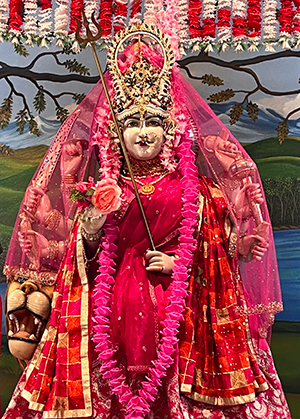
The Deities at Vijay's Sherawali Temple have a remarkable backstory. Maa Sherawali was actually commissioned by Vijay in 2001 in Jaipur, India. With plans of placing her at the South San Francisco Temple. Since the plans were never approved by the city to use the site as a temple. Mata arrived weighing almost 2 tons in a large wooden crate. Vijay and his best friend Raju and a group of gentleman brought Mata Rani to Vijay's home in South San Francisco with plans to place her inside. Due to Mata's sheer size they failed to do so hilariously. After many failed attempts the group of men were not able to lift her up. So one night Saras (Vijay's wife) and a group of Jagratis gathered around Mata and started chanting Jai Bajrang Bali and lifted with all their might. Mata started to rise. The men were stunned how they were able to accomplish such a task. Mata Rani took her place in Vijay and Saras Chand's garage for 20 years. He built his office, kitchen, friendships and conversations with Mata. He even would not eat until Mata's bhog went out first.
Ganesh, Shiva, and Hanuman were all part of the plan. Vijay commissioned them as well in 2001. Due to the temple plans in South San Francisco failing. Space was limited in the garage so the three Deities awaited in India for 20 years. When Saras and Romiel flew to India to complete Vijay's Antyesti. They traveled to Jaipur and completed the arrangements to bring the remaining Deities to California. Surprisingly, they remembered the family from their first visit in 2001 and showed them where the Deities were resting all these years.

Goddess Durga
Goddess Sherawali is one of the numerous names of Godess Durga. Mother Goddess is referred as Maa Sheravali mostly in North India.
Durga, meaning in Sanskrit: “the Inaccessible, Impassable, Invincible” in Hinduism, a principal form of the Goddess, also known as Devi and Shakti.
Durga was created for the slaying of the buffalo demon Mahishasura by Brahma, Vishnu, Shiva, and the lesser gods, who were otherwise powerless to overcome him. Embodying their collective energy (shakti), she is both derivative from the male divinities and the true source of their inner power. She is also greater than any of them. Born fully grown and beautiful, Durga presents a fierce menacing form to her enemies. She is usually depicted riding a lion and with 8 or 10 arms, each holding the special weapon of one of the gods, who gave them to her for her battle against the buffalo demon. Durga Puja Navratri (Nine nights) held annually in her honour, is one of the great festivals of northeastern India.

Lord Ganesha
Ganesh (also spelled Ganesa or Ganesha and known as Ganapati, Vinayaka and Pillaiyar) is the Lord of Good Fortune who provides prosperity, fortune and success. Ganesha is the son of Shiva and Parvati. He is the Lord of Beginnings and the Remover of Obstacles of both material and spiritual kinds. Interestingly, he also places obstacles in the path of those who need to be checked. The 10-day late-summer (August–September) festival Ganesh Chaturthi is devoted to him.
Fun fact: due to his renowned wisdom and intelligence. He was asked by Vyasa to transcribe the Mahabharata. In addition, his form and sacred symbols all have deeper meanings.

Lord Shiva
Lord Shiva – is one of the most important gods in the Hindu pantheon and is considered a member of the holy trinity (trimurti) of Hinduism with Brahma and Vishnu. While Lord Brahma plays the role of a Creator and Lord Vishnu plays the role of the Preserver, Lord Shiva, is essentially the Destroyer. Together these three Lords symbolize nature’s rules, which is everything that is created is eventually destroyed.
In Hinduism, the universe is thought to regenerate in cycles (every 2,160,000,000 years). Shiva destroys the universe at the end of each cycle which then allows for a new Creation.
Lord Shiva in Lingam form:
A Shiva Lingam has three distinct parts which are considered as Brahma, Vishnu, and Shiva. The lower part represents Brahma, the middle Vishnu, and the upper and the most prominent represents Shiva. Thus, Shiva Lingam represents all the three powers in one- as the Para Brahma or Supreme Shiva consciousness. Please see sketch below.


Lord Hanuman
Lord Hanuman – the monkey commander of the monkey army. His exploits are narrated in the great Hindu Sanskrit poem the Ramayana (“Rama’s Journey”).
While still a baby, Hanuman, the child of a nymph by the wind god, tried to fly up and grab the Sun, which he mistook for a fruit. Indra, the king of the gods, struck Hanuman with a thunderbolt on the jaw (hanu), thus inspiring the name. When Hanuman continued to misbehave, powerful sages cursed him to forget his magic powers, such as the ability to fly or to become infinitely large, until he was reminded of them. Hanuman led the monkeys to help Rama, an avatar (incarnation) of the god Vishnu, recover Rama’s wife, Sita, from the demon Ravana, king of Lanka. Having been reminded of his powers by Jambavan, the king of the bears, Hanuman crossed the strait between India and Lanka in one leap, despite the efforts of watery demonesses to stop him by swallowing him or his shadow. He was discovered in Lanka, and his tail was set on fire, but he used that fire to burn down Lanka. Hanuman also flew to the Himalayas and returned with a mountain full of medicinal herbs to restore the wounded in Rama’s army. For his service to Rama, Hanuman is upheld as a model for all human devotion (bhakti)



